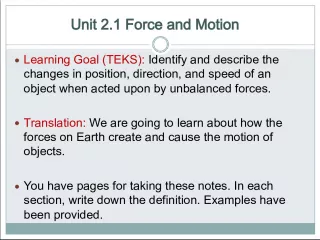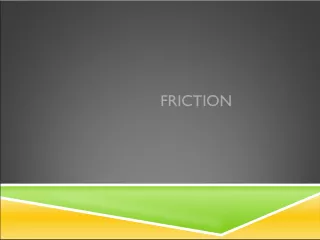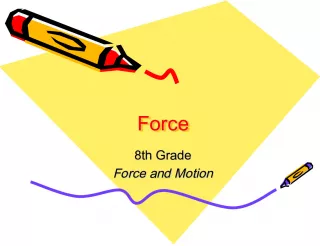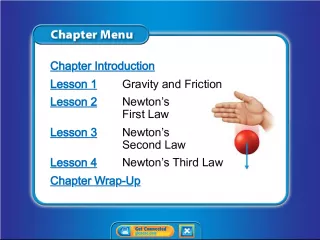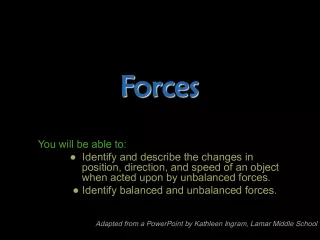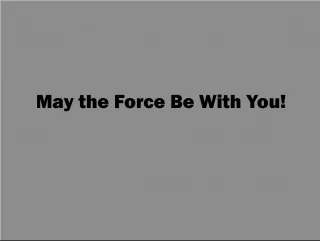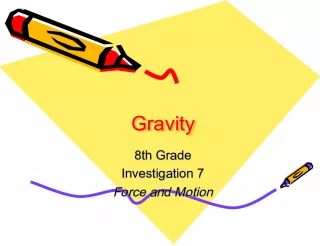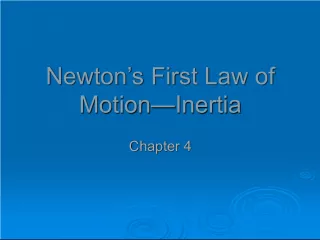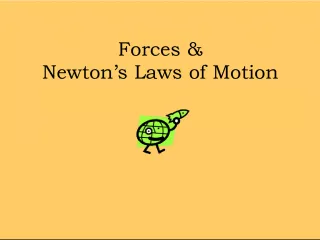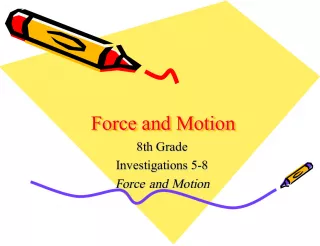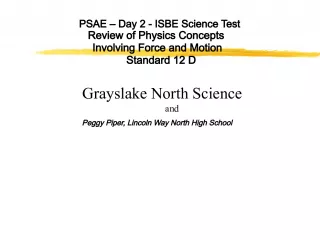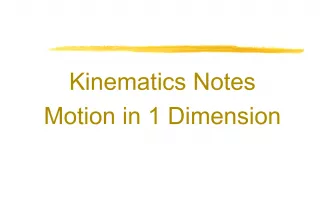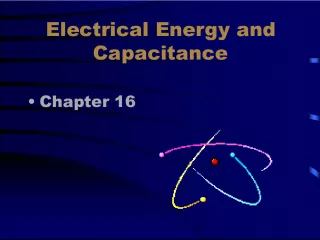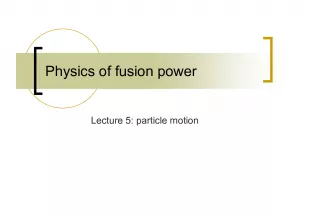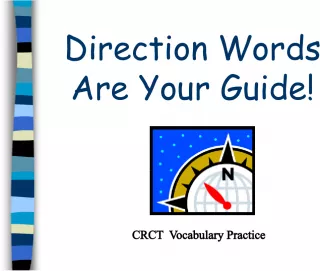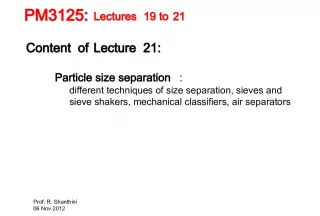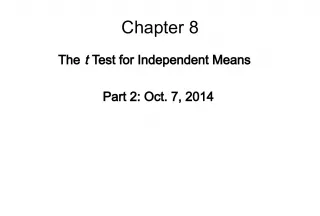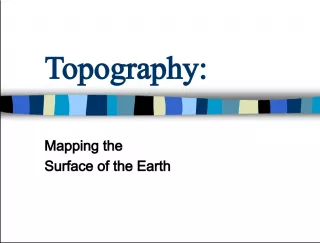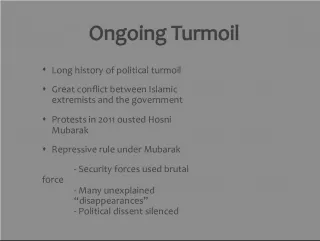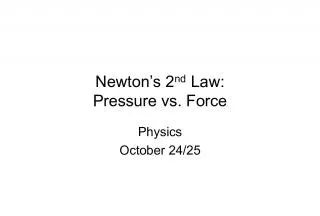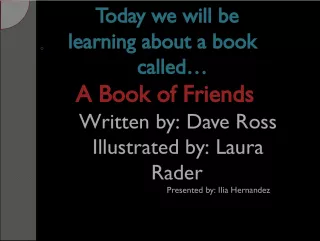Forces and Motion: Understanding Direction and Size of Force


This article explains the concept of force in motion and how it influences the movement of objects. A force is a push or a pull that an object exerts on another object.
- Uploaded on | 0 Views
-
 gonzalo
gonzalo
About Forces and Motion: Understanding Direction and Size of Force
PowerPoint presentation about 'Forces and Motion: Understanding Direction and Size of Force'. This presentation describes the topic on This article explains the concept of force in motion and how it influences the movement of objects. A force is a push or a pull that an object exerts on another object.. The key topics included in this slideshow are . Download this presentation absolutely free.
Presentation Transcript
Slide1Forces and MotionForces and Motion 2 2 Force • A force is a push or a pull that one object exerts on another object. • Objects like floors, chairs, and Earth also exert forces on other objects, including people.
Slide2Forces and MotionForces and Motion 2 2 Force Has Direction and Size • Just like velocity and acceleration, a force has both size and direction. • The direction of a force is the direction of the push or pull. • Pushing or pulling harder increases the size of the force you exert. The size of a force is measured in newtons (N).
Slide3Forces and MotionForces and Motion 2 2 How Forces Combine • When more than one force acts on an object, the forces combine. • The combination of all the forces acting on an object is the net force .
Slide4Forces and MotionForces and Motion 2 2 Combining Forces in the Same Direction • When two forces act in the same direction on an object, like a box, the net force is equal to the sum of the two forces.
Slide5Forces and MotionForces and Motion 2 2 Combining Forces in Opposite Directions • If two forces of equal strength act on the box in opposite directions, the forces will cancel, resulting in a net force of zero.
Slide6Forces and MotionForces and Motion 2 2 Combining Forces in Opposite Directions • When two unequal forces act in opposite directions on the box, the net force is the difference of the two forces.
Slide7Forces and MotionForces and Motion 2 2 Balanced and Unbalanced Forces • When the net force on an object is zero, the motion of the object doesn’t change. • The forces acting on an object are balanced forces if the net force is zero. • The forces acting on an object are un balanced forces if the net force is not zero.
Slide8Forces and MotionForces and Motion 2 2 Contact and Non-contact Forces • A force is exerted when one object pushes or pulls on another. • A force that is exerted only when two objects are touching is a contact force . • Non-contact forces are forces that can be exerted by one object on another even when the objects aren’t touching.
Slide9Forces and MotionForces and Motion 2 2 Gravity • Gravity is a non-contact force that every object exerts on every other object due to their masses. • The gravitational force between two objects is an attractive force that tends to pull the two objects closer together.
Slide10Forces and MotionForces and Motion 2 2 Gravity • The size of the gravitational force between two objects depends on the masses of the objects and the distance between them. • The gravitational force between two objects increases if the mass of one or both of the objects increases. • If two objects move closer together, the gravitational force between them increases.
Slide11Forces and MotionForces and Motion 2 2 Mass and Weight • Because weight is a force, it is measured in newtons. • Weight is not the same as mass. Mass is the amount of matter an object contains, and is measured in kilograms.
Slide12Forces and MotionForces and Motion 2 2 Friction • Friction is a contact force that resists the sliding motion of two surfaces that are touching. • Friction causes a sliding object to slow down and stop. • Friction also can prevent surfaces from sliding past each other.
Slide13Forces and MotionForces and Motion 2 2 Static Friction • Static friction is the force between two surfaces in contact that keeps them from sliding when a force is applied.
Slide14Forces and MotionForces and Motion 2 2 Sliding Friction • Sliding friction exists between all sliding surfaces that are touching. • Sliding friction is the force that opposes the motion of two sliding surfaces in contact.
Slide15Forces and MotionForces and Motion 2 2 What causes friction? • When two surfaces are in contact, the surfaces stick to each other where the dips and bumps on one surface touch the dips and bumps on the other surface. • Friction is caused by the sticking of the two surfaces at these bumps and dips.
Slide16Forces and MotionForces and Motion 2 2 The Buoyant Force • The buoyant force is a force exerted by a fluid on an object that is in the fluid. • The buoyant force is always upward. • If you are floating in water, the buoyant force is large enough to balance your weight.
Slide17Forces and MotionForces and Motion 2 2 Air Resistance • Air resistance is a contact force that opposes the motion of objects moving in air. • Just like friction, air resistance acts in the direction opposite to an object’s motion. • Air resistance is less for a narrow, pointed object than for a wide, flat object.
Slide1822 Section Check Section Check Question 1 A force is a _______ or a _______. Force is a push or a pull. Answer FL: SC.C.2.3.2
Slide1922 Section Check Section Check Question 2 A force exerted between two objects that are not touching is known as _______. The answer is a long-range force. Gravity is a long-range force; although we are not touching the Sun, our planet is being acted on by the Sun to keep it in orbit. Answer FL: SC.C.2.3.1
Slide2022 Section Check Section Check Question 3 You try to push a desk across the floor one direction but a friend is trying to push it the opposite direction. As a result, the desk doesn’t move. This is an example of what kind of forces? A. balanced forces B. continuing forces C. extended forces D. unbalanced forces FL: SC.C.2.3.6
Slide2122 Section Check Section Check Answer The answer is A. When forces are balanced, the net force is zero. FL: SC.C.2.3.6
Slide22The Laws of MotionThe Laws of Motion 3 3 The First Law of Motion • According to the first law of motion , if the forces acting on an object are balanced, then an object at rest remains at rest and an object in motion keeps moving in a straight line with constant speed. • When the forces on an object are balanced, the motion of the object doesn’t change.
Slide23The Laws of MotionThe Laws of Motion 3 3 The First Law of Motion • The forces on an object are unbalanced when the net force on the object is not zero. • According to the first law of motion, for an object to change speed or direction, the net force acting on the object must not be zero.
Slide24The Laws of MotionThe Laws of Motion 3 3 Changing Direction • Then the direction of motion curves toward the direction of the unbalanced net force. • A moving object changes direction when the net force acting on the object is not in the same direction as the object’s motion.
Slide25The Laws of MotionThe Laws of Motion 3 3 The Second Law of Motion • Newton’s second law of motion describes how the net force on an object, the mass of the object, and the acceleration of the object are related. • According to the second law of motion , the acceleration of an object depends on the net force acting on the object and the object’s mass.
Slide26The Laws of MotionThe Laws of Motion 3 3 Acceleration and Mass • Acceleration is larger when the speed of an object changes more quickly. • If the net force is the same, the acceleration of an object decreases as the mass of an object increases.
Slide27The Laws of MotionThe Laws of Motion 3 3 Acceleration and Direction of the Net Force • According to the second law of motion, when a force acts on an object, its acceleration is in the same direction as the force. • When an object slows down, the direction of its acceleration is opposite to its direction of motion.
Slide28The Laws of MotionThe Laws of Motion 3 3 Acceleration and Net Force • When you lift your backpack, its speed depends not only on its mass, but also on the force you exert. • According to the second law of motion, the acceleration of an object increases when the net force on the object increases.
Slide29The Laws of MotionThe Laws of Motion 3 3 The Third Law of Motion object exerts an equal force in the opposite direction on the first object. • The third law of motion , states that when one object exerts a force on a second object, the second
Slide30•The forces in a force pair act in opposite directions and are always equal in size. The Laws of Motion The Laws of Motion 3 3 Force Pairs • The forces two objects exert on each other are called force pairs.
Slide31•For every action force, there is a reaction force that is equal in size, but in the opposite direction. The Laws of Motion The Laws of Motion 3 3 Action and Reaction • One force of the force pair is called the action force, and the other force is the reaction force.
Slide32The Laws of MotionThe Laws of Motion 3 3 Action and Reaction • The swimmer’s hands exert a backward action force on the water. • The water then exerts a forward reaction force on the swimmer. This is the force that propels the swimmer forward.
Slide33Section CheckSection Check 3 3 Question 1 Newton’s second law of motion states that _________ of an object is in the same direction as the net force on the object. A. acceleration B. momentum C. speed D. velocity FL: SC.C.2.3.6
Slide34Section CheckSection Check 3 3 The answer is A. Acceleration can be calculated by dividing the net force in newtons by the mass in kilograms. Answer FL: SC.C.2.3.6
Slide35Section CheckSection Check 3 3 Question 2 The forces two objects exert on each other are called _______. A. action pairs B. force pairs C. gravity D. reaction pairs FL: SC.C.2.3.3
Slide36Section CheckSection Check 3 3 Answer The answer is B. The forces in a force pair act in opposite directions and are always equal in size. FL: SC.C.2.3.3
Slide37Section CheckSection Check 3 3 Question 3 When an object slows down, the direction of its acceleration is _______ its direction of motion. A. the same as B. opposite C. behind D. in front of FL: SC.C.2.3.5; SC.C.2.3.6
Slide38Section CheckSection Check 3 3 Answer The answer is B. When you stop a ball from rolling, the force of your foot is opposite the direction of motion of the ball. FL: SC.C.2.3.5; SC.C.2.3.6
Slide39to advance to the next item or next page click on anyof the following keys: mouse, space bar, enter, down or forward arrow. Click on this icon to return to the table of contents. Click on this icon to return to the previous slide. Click on this icon to move to the next slide. Click on this icon to open the resources file. Help Help Click on this icon to go to the end of the presentation.
Slide40End of Chapter Summary File
